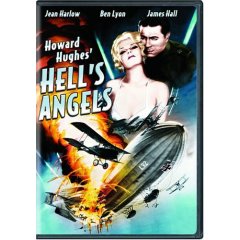Coming from radio and the stage, Orson Welles was a hot prospect for Hollywood. RKO won the bidding for his services (a decision they would soon regret), and Welles was given full autonomy on his first film, Citizen Kane. Surveying the entire film studio before him, he famously described it as “the biggest train set a boy ever had.”
No one took that idea to further extremes, unsurprisingly, then Howard Hughes. In the late ’20s, when he was still pursuing his manias instead of his manias pursuing him, Hughes began making films. He had some success, but as he went crazier, his films went downhill. Early in that process he decided, given his interest in aviation, to make a film about World War I air combat.
His craziness, however, manifested itself here, as he spent years and nearly four million dollars (back when that meant something) on the film. At one point, with the film finally majorly completed, he decided he had to go back and re-shoot as a sound picture, which were just coming into vogue. He even shot some of the scenes in an early color process.
Along the way he fired the original Norwegian lead actress, whose accent made her unworkable in a sound picture, and inserted one of his many Hollywood discoveries, the sultry and teenaged Jean Harlow. Ms. Harlow later tragically died at the age of 26.
Although Hughes produced some good films, and even a classic like Scarface (1932), he is more remembered by a certain, er, elite population of film buffs for his disastrous later flicks like The Outlaw (for which Hughes spent a fair amount of time using his engineering knowledge to design a special bra to best showcase Jane Russell’s impressive rack), Jet Pilot, and particularly the ill-fated The Conqueror, in which John Wayne played Genghis Khan (!), and during which it is theorized that the cast was exposed to radioactive sands due to the then recent and nearby A-bomb tests in New Mexico. Nearly all of the major players associated with the film, including Wayne himself, eventually died of cancer.
Hell’s Angels is a queer duck. The turgid melodrama stuff is frankly awful, stagy and unbelievable in the way you only see in films of the ’30s. As expected, the acting is equally bad, including Harlow’s. She’s sexy, all right, but not exactly chasing any Oscars here. (On the other hand, modern viewers may be surprised by how sexually frank, if non-explicit, this pre-Hayes Code movie is.)
Basically, two British brothers are at university when World War I breaks out. (There’s also a subplot about a German friend of theirs who is aghast, having falling in love with Britain during his studies there.) Two is noble and brave, although he picks poorly in love, falling madly for the slutty Harlow. The other brother is a callow cad. The stuff with them is frankly quite painful at times, and creaky throughout. And I’m not somebody unsympathetic to films of that vintage.
However…wow. The air stuff, which is what cost Hughes most of his four million bucks, is insanely awesome. There are two long set pieces in the film that make it worth watching, and perhaps even buying, on their own.
The climatic dog fight between a squadron of British and German fighters is crazy stuff, filmed with real planes and pilots. Some of the shots were so crazy that Hughes had to go up and shoot them himself, because his cameramen refused. The result pays off, though. This is some of the best war footage ever—and certainly puts the CGI shenanigans of the recent Fly Boys to shame (in which animated biplanes zip around like Tie Fighters to make them more “exciting”)—and features some shockingly realistic and unpleasant death scenes. Nobody knew better than Hughes how bad one’s demise in an early plane could be, and he doesn’t pull any punches in showing us.
The real eye popper, though, is the long sequence that ends the first half of the film, which follows a German zeppelin conducting a bombing raid, and the efforts of some of the British biplane pilots to shoot it down. I can’t stress enough how spectacular this scene is, and it features some model work that I still find amazing nearly eighty years later. Wow. If nothing else, get a copy of this film just to watch this sequence, and the final dogfight. It’s extraordinary stuff.
In the end, Hughes did recoup his money, and more, on this film. (If I remember right, there is a good deal on the making of this film in Martin Scorsese’s Hughes biopic The Aviator.) Of course, as we all know, things didn’t turn out so well for him in the long run.

